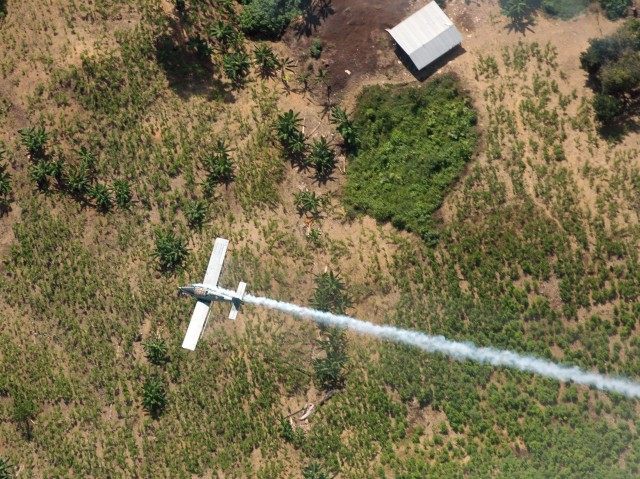Colombia has overturned its decision to suspend the aerial spraying of an herbicide used to kill illegal coca crops, according to the country’s government.
The use of the herbicide glyphosate — considered a bastion of Plan Colombia, an anti-drug trafficking aid package funded with billions in U.S. taxpayer funds — was suspended less than a year ago due to cancer concerns and an alleged deal with the terrorist group Revolutionary Armed Forces of Colombia (FARC).
Luis Carlos Villegas, Colombia’s defense minister, reportedly explained that the herbicide will no longer be dumped from crop dusters piloted by Americans as it has been done for nearly 20 years.
Instead, the pesticide will be administered on the ground manually by eradication crews.
“We’ll do it in a way that doesn’t contaminate, which is the same way it’s applied in any normal agricultural project,” Villegas told La FM radio, noting that expected the final licensing process to culminate this week, local and international news outlets report.
“Villegas didn’t say why the government was switching gears or under what circumstances the weed killer would be applied,” notes the Associated Press (AP).
The defense minister did concede that the government has been concerned by an increase in the cultivation of illicit crops across the country, largely due to the suspension of the aerial spraying last year, reports Colombia’s RCN Radio.
In May 2015, Colombia’s President Juan Manuel Santos recommended halting the use of the herbicide.
Santos’s decision came on the heels of a report by the U.S. Office of National Drug Control Policy, which revealed that the cultivation of coca, the main ingredient in cocaine, had increased 39 percent in 2014 over the previous year.
The U.S. taxpayer-funded aerial spraying program has fumigated 4 million acres of crops since it began in 1994 at an estimated cost of $2 billion. The 2014 spike in cultivation occurred after six straight years of declining or steady production.
In 2015, coca cultivation jumped another 42 percent to 392,000 acres, according to the U.S. government. That year, the United States estimates that Colombia may have potentially produced 420 metric tons of cocaine, a nearly 70 percent increase from 250 metric tons the previous year.
Two other factors that likely contributed to Colombia’s decision to stop its aerial fumigation efforts are the World Health Organization’s warning that glyphosate is “probably carcinogenic” and the demands by the FARC.
“The International Agency for Research on Cancer, a French-based research arm of WHO, reclassified the herbicide as a carcinogen last year, citing evidence that the herbicide produces cancer in lab animals and more limited findings that it causes non-Hodgkin’s lymphoma in humans,” reports AP.
“Monsanto and other manufacturers of glyphosate-based products strongly rejected the ruling,” continues the report. “They cited a 2012 finding by the U.S. Environmental Protection Agency that the herbicide is safe.”
FARC, which the government accuses of financing itself with illicit drug proceeds, requested that aerial spraying be halted as part of any final peace process.
Rep. Robert Pittenger (R-NC), chairman of the Congressional Task Force on Terrorism and Unconventional Warfare, told Breitbart News that shelving the use of the herbicide strengthened FARC.
“[Cocaine] Production is way up, the volume, revenue is way up,” he declared, potentially providing FARC the opportunity to reach out to other terrorist groups and conduct business.
AP notes that the left-wing terrorist group has long compared the use of the crop killing chemical to the United States’s use of Agent Orange in Vietnam.
“But conservative critics warned that without glyphosate Colombia would soon be awash in coca,” adds the report.
The pesticide ban was heralded by opponents of the war against drugs and environmentalists.

COMMENTS
Please let us know if you're having issues with commenting.